Fresh Egg’s Five Steps to Content Marketing Excellence – Part One
By Intern |22 Jul 2015
Content marketing is now a mainstream digital marketing activity – the battle to grab and hold people’s attention with content is growing in intensity. In this Darwinian ecosystem only the strongest content, the most astute strategies and the best promotion will win.
This is why Fresh Egg leaves no stone unturned in its pursuit of content marketing excellence, and why we apply our five-step approach to this discipline:
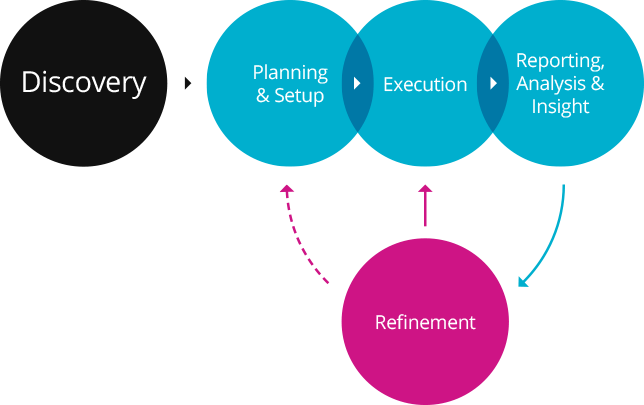
Fresh Egg's five-step approach: Discovery, Planning & setup, Execution, Reporting and Refinement
In fact, we apply this five-step approach to all of our digital marketing disciplines, reflecting Fresh Egg’s passion for delivering excellence and value for money.
In this first blog post, we’ll explore our overall approach and then dive a bit deeper into step one, Discovery.
Why five steps?
We’ve found that applying our five-step approach allows us to build our creative excellence on the solid foundation of in-depth research. Then, by ensuring accurate measurement of the appropriate metrics, our strategies can be further refined to drive even greater success.
So, what do our five steps actually entail?
1. Discovery
In this phase of our content marketing activity, Fresh Egg produces its audience intent research to help define your audience groups and find where they are online. This will drive an understanding of the content needed to meet the needs of these groups, what form the content needs to take, and how it can be optimised to suit their needs. Once we have defined these groups, we then audit your onsite content to see how it meets these groups’ needs, to find gaps and ensure all future content marketing activity is supported with the best possible onsite experience.
2. Planning and setup
The content strategy then takes insights from the audience intent and content audit work to plan, promote and refine your content marketing. We propose relevant user journeys, incorporate methods for efficient content production, and define how you should be measuring the performance of this content. This activity has the sole purpose of driving the best possible return on your content marketing investment.
3. Execution
Fresh Egg can work with your business in a number of ways to produce the best-in-class content your audience groups need: we can create content for you, consult with your in-house teams to optimise their output, or even help with the repurposing of existing content assets to meet the needs of your strategy. Then, once this content is created, we can then use the information gleaned during the audience intent investigation to promote it in the relevant places, using the relevant influencers to drive success.
4. Reporting, analysis and insight
Planning the measurement of the content you produce is essential – without relevant benchmarks, it is impossible to understand your content well enough to drive further success. Our approach (ideally combined with work from our insight team to ensure your measuring systems are robust) makes sure you have the tools to measure and report on your content marketing.
5. Refinement
Implementing a culture of measuring, learning and refining is essential for tuning your content marketing to the needs of your audience, driving higher audience engagement and, ultimately, conversions.
The Discovery phase in detail
So, let’s take a deeper look at our Discovery phase. (The following section is just a taster of the work we do. For more details, contact our team – we’ll be happy to discuss how we can best help your business.)
Discovery and data
Competition for your audience’s attention has never been greater, so the deeper the insight you have into its behaviour and the cues that will drive engagement the better the outcome of your content marketing.
Most businesses already have data about their audience groups. In this case, our audience intent work takes this existing information to the next level, by combining it with our knowledge of how to investigate these groups’ digital universes.
This information can then be used to drive an even deeper understanding of how to reach your audience.
The following example from one of our audience intent documents compares demographic information supplied to us about a client’s existing customer groups with publicly available data related to consumption of their products. This information was then used to drive a strategy of promoting content to more relevant geographic areas.
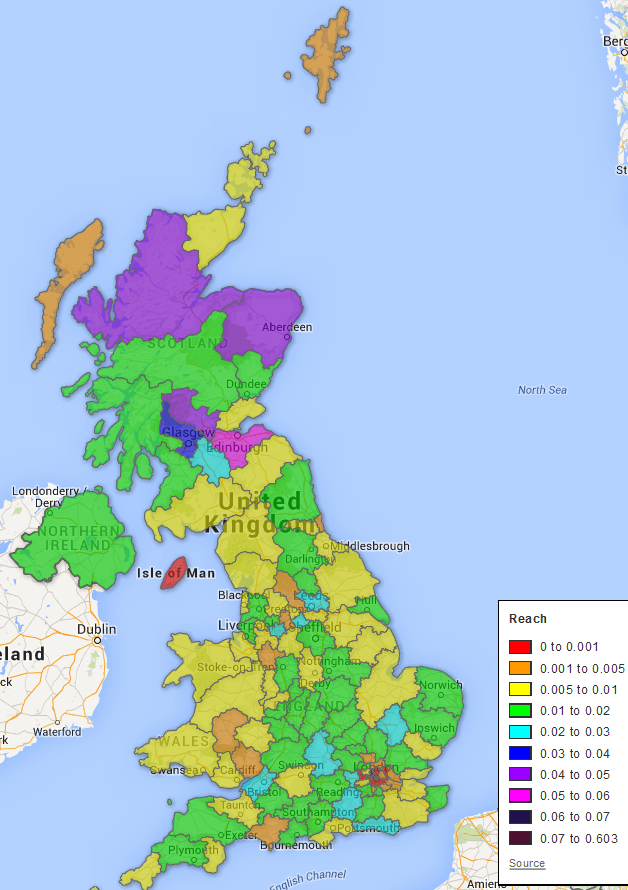
A map plotting the reach of a product for relevant demographic groups
User intent and search
For each audience group, we also carry out our own audience-based search investigation using an in-house tool created by our Head of Innovation, Dr David Sewell.
This tool takes likely search phrases entered into the major search engines by each audience group, and suggests topic variations based on the search engine's output. This gives an overview of related topics for various audience groups and is a great starting point for content creation.
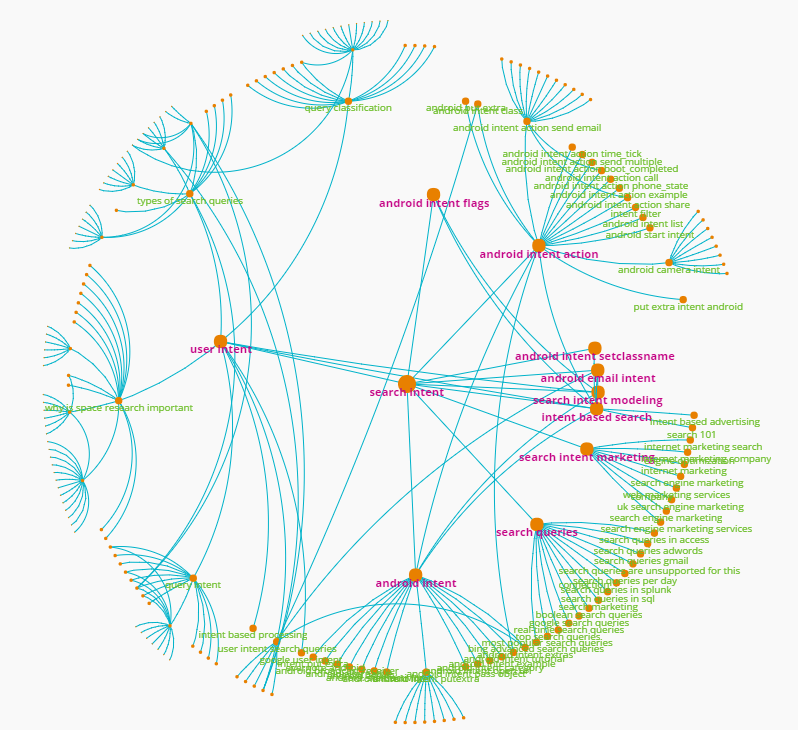
A graph of related search phrases produced by our search intent tool
The graph above illustrates the output from this tool to give an indication of the topics users are interested in.
All of this work is combined with data sources, such as Google Trends, location-based search intent, organic research and more. The combined work creates a definitive view of your audience, the content it wants to consume and where it goes to find this information.
To round off this view of your audience groups we also investigate the buying cycle, digital marketplaces, psychographic framing, and more.
Optimising onsite
To give your content marketing the best possible chance of success, you need to understand your audience groups and where they are online. However, that knowledge is not enough for content marketing success. What about the experience they have when they eventually land on your site?
This is why our approach recommends an audit of your site’s existing content.
To get the best results from any offsite content work, your site needs to offer the information your audience groups need at all of the relevant stages of the journey to conversion. And your site must provide this information in ways your audience groups will want to consume it.
Here’s a sample of what we audit your site for, depending on your business needs:
Readability and standards
First we examine the basics, such as how easy your audience will find your content to read or consume. Google’s Panda checklist confirms the importance of this belt-and-braces approach.
Here’s the output of one of the tools we use to check content readability:
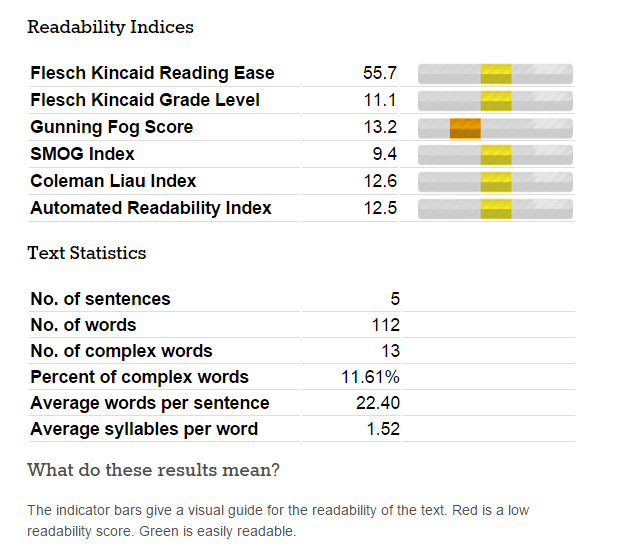
The output of Read-able.com’s reading ease tool
Wikipedia gives you more information about the above output of this tool, Read-able.com, and its relevance.
And here’s a table from one of our content audits, with examples of the standards we audit for:
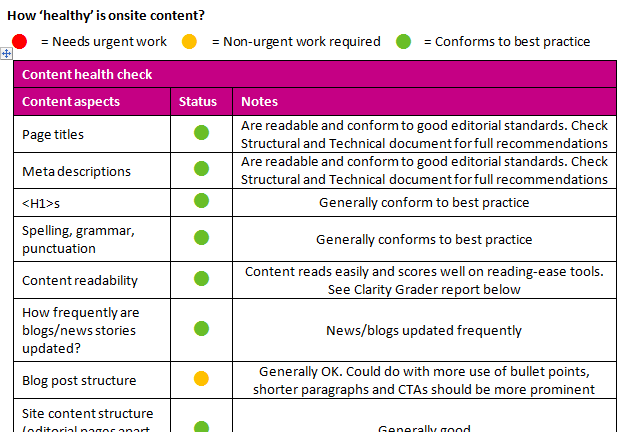
Example table from one of Fresh Egg's content audits
Technical onsite content issues
For your onsite content marketing to have optimum organic visibility, it needs to conform to SEO best practice, and our discovery work by the technical SEO team is essential here. To supplement this, our work also audits for technical content issues that may hamper your content marketing efforts, such as duplicate content:
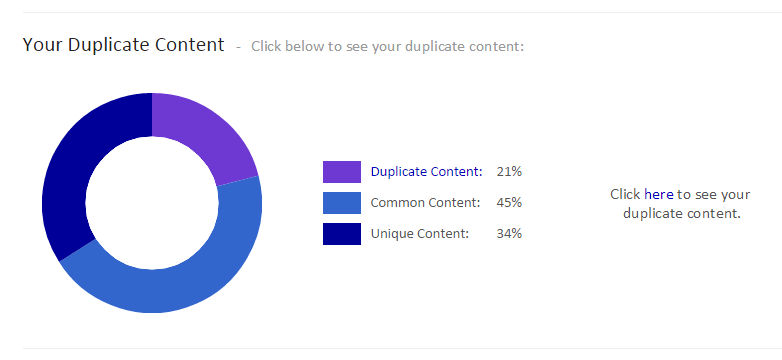
Example duplicate content analysis
Or thin content:

Example thin content analysis
Audit overview
Our audits go much deeper than the above investigations, however. Fresh Egg also researches how your site content:
- Meets the needs of the buying cycle
- Compares with competitor activity and standards
- Performs against an in-depth drill down into search intent
- Meets the needs of users on various devices
- Is performing in terms of social shares, backlinks and engagement metrics
- Is meeting the needs of your audience for varied content types
The exact nature of the discovery work we carry out for your content marketing will depend on factors such as what you are looking to achieve, the nature of the products or services you are promoting, as well as the scope of other digital marketing activity you have planned.
So, that's about all for this post. Keep an eye out for out next blog in this series about content marketing, when we’ll cover the remaining four steps in the Fresh Egg approach: planning and setup, execution, measurement and refinement.
Get in touch with us to find out how content marketing can engage your audience and, ultimately, drive your business forward.
Want to find out more before you contact us? Learn about the content marketing services we offer at Fresh Egg.